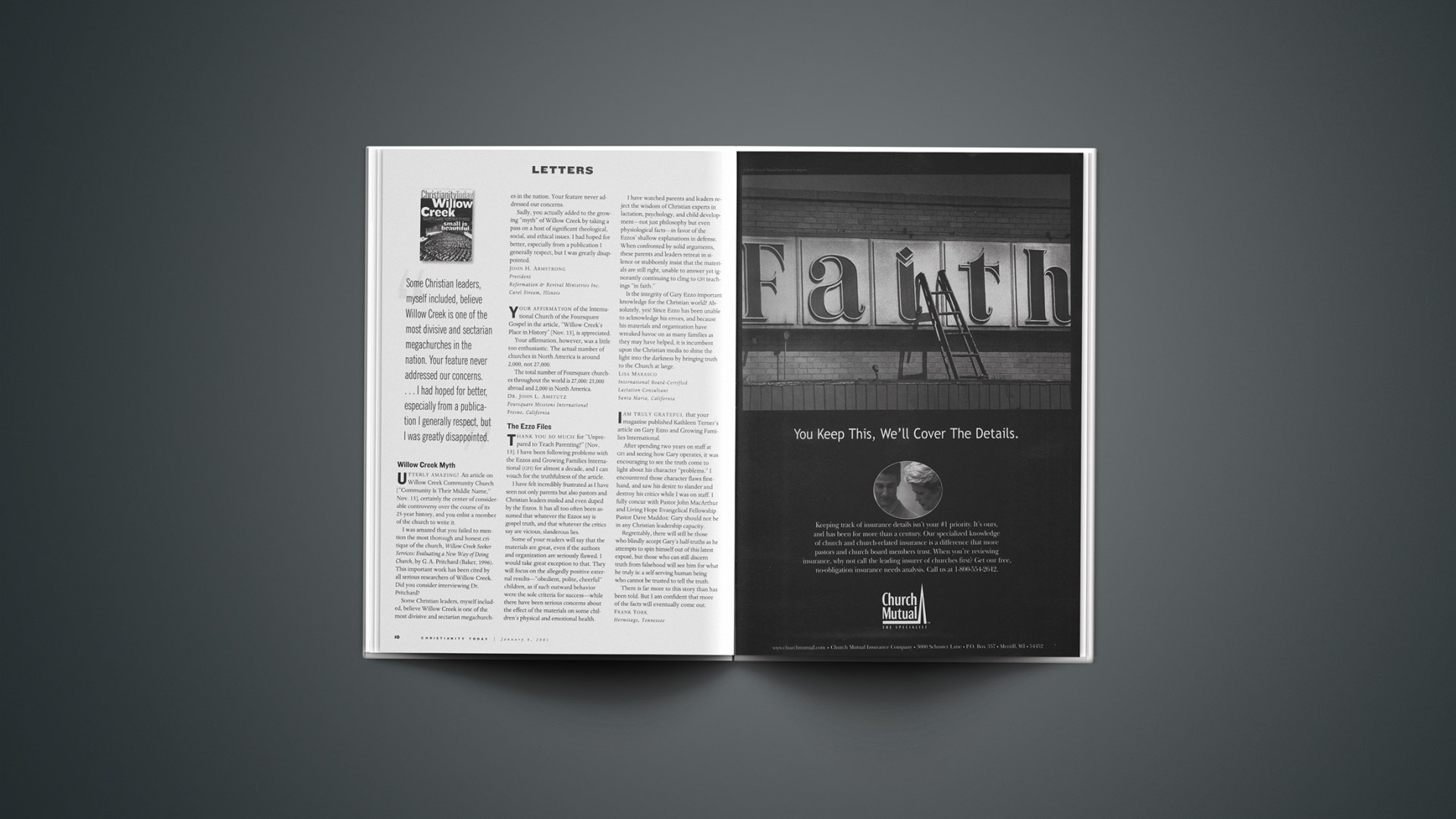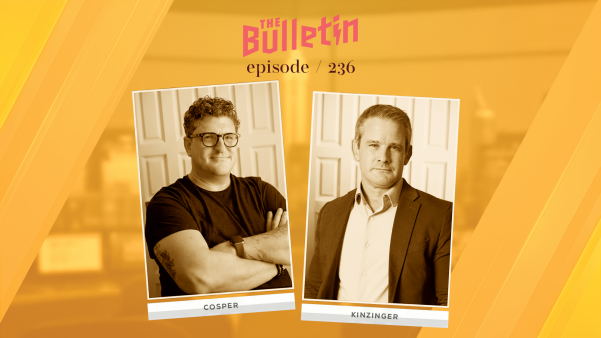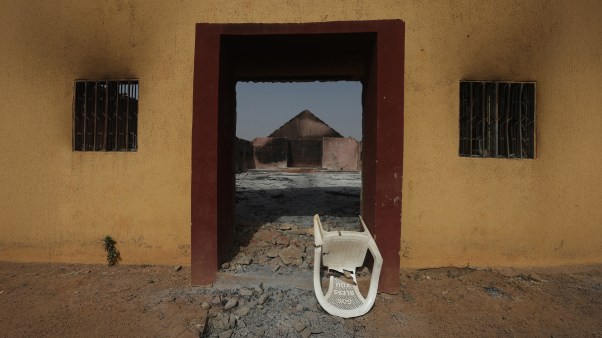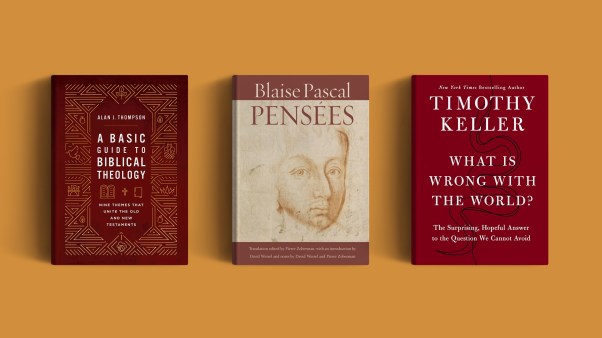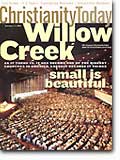
Not far from the city of Secunderabad, in a boulderstrewn landscape, the Uddamarry Good Shepherd School models the new approach of Operation Mobilization India (OMI). A simple cement structure, Uddamarry educates several hundred bright-eyed children from 14 villages. Most students at Uddamarry are Dalits—members of the "untouchable" caste that composes the lowest rung on Indian society's ladder. They long for education.
In this rural setting, where Christianity has never gained a foothold, children are learning Bible verses—and so are their families. Almost three times as many students have applied for admission as the school can accommodate.
OMI teachers live in the surrounding villages, one married couple per three villages. OMI teachers are viewed with great respect. When they start church fellowships in their homes, they do not encounter the same level of resistance as do traditional missionaries.
Churches are opened as the school gains credibility. Then comes a variety of development schemes. In Uddamarry, OMI has started a tailoring school where workers stitch the students' blue uniforms.
There is also a small health clinic, a microenterprise office, and a self-help center. All projects work in concert, demonstrating a holistic gospel in a place where the name of Jesus is scarcely known. OMI offers Christmas programs, Awana children's clubs, vacation Bible school, and other programs. They invite local officials to these events. The gospel gradually becomes less foreign, hostility fades, and interest in Christ grows.
Ragland Rameshwarren, who oversees OMI's community development projects in Uddamarry, says, "In the old days, there was no place for me. You had to become a pastor or an evangelist. But now we are so happy. I am giving back what was given to me. We are bringing the gospel to people's doorsteps."
Banning Westerners Helped
OMI did not start out this way. "When I first went to India in 1964," says Operation Mobilization (OM) founder George Verwer, "I knew right away this was my nation of destiny. I immediately moved my whole family there and made it a priority."
Historically a hot-gospel, street-preaching, tract-distributing ministry, OM is one of the world's largest mission organizations, working in 115 countries through 6,000 staff members.
In the early years, leaders convened annually in Belgium and then dispersed teams around the globe. Some headed overland for India in donated vans and trucks. They spent the year living in those vehicles, crisscrossing the subcontinent and telling anybody who would stand still about Jesus. They sold tracts and Bible portions to support themselves.
Those gospel pilgrims were inclusive, evangelistic, and itinerant. OM attracted countercultural young people who were open to adventure. Many of the first missionaries to India had studied at Oxford and Cambridge. As Verwer notes, "Indians admired university students," and the fact that the elite students had adopted a simple life of discipleship "got gossiped [about] across the country."
Peter Dance remembers his first trip to India in 1972, driving a truck that had been reconditioned in England. "It was cold and wet and scary. We went across the Austrian border, and I had the feeling of, there is no one there to help me anymore except Jesus.
"Before I crossed that border, I had everything I needed; even my mother was there if I needed her. I went to India many times, and through breakdowns and difficulties, the Lord always came through."
As young Indians came to Christ, they joined OM's evangelistic teams. Indians and Westerners lived together on equal terms, experiencing exhilarating freedom while witnessing to their faith. "India in 1972 was very Western-led," Dance says. "Those leaders felt strongly that if the movement was going to continue, it needed to bring in and train national leaders. The ethos was discipleship." That discipleship happened as they witnessed, lived, and traveled together.
Verwer saw a bigger picture. He urged South India Christians to go north—where few Christians lived—and to train local northerners for leadership. "Verwer trusted us, believed in us," says Alfy Franks, now bishop of the 3,000 Good Shepherd churches that make up OMI's core structure.
But in 1968, the government barred Verwer. Forty years passed before he could re-enter the country. In his sudden absence, Indian staff had to rise to a new level of leadership. In the 1980s, greater stress came with restrictions on visas for missionaries. India's Christian organizations had to look to local resources.
In retrospect, it was a blessed necessity, leading OMI to become a truly national organization. In the vast subcontinent, with its hundreds of languages and caste differences, people tend to stay most loyal to their own group.
"We were a pan-Indian, pan-caste movement," says OMI leader Joseph D'souza. "That can be very painful. We have had our own divisions and fights, but out of them we created our own special ethos."
Indian leaders recognized something that Western OM leaders might never have seen: that study and training were crucial for new believers. Many had no biblical background, nor did they grasp Christian ideas of God, sin, and forgiveness. OMI began to invest in formal education, developing training institutions.
OMI has trained 25,000 leaders since 1964. On its sprawling campus near Secunderabad, the organization prepares both pastors and schoolteachers. The International College of Cultural Studies offers two bachelor's and four master's degrees. OMI went from distributing tracts to developing the largest Christian publishing house in India.
Dasan Jeyaraj is an appropriate choice to head the International College of OMI. He grew up one of eight children in a Dalit family. When Jeyaraj was 10, his mother could not repay a significant debt and sent Jeyaraj to work for a high-caste Christian family in Chennai, 425 miles away. "I cried. I thought my life had ended. Once, I ran away, but they caught me and sent me back," he says.
As a 10-year-old, he did all the household work: grinding spices, mopping floors, washing clothes, shopping, helping cook, and taking children to school. The family allowed him to go to Sunday school and church. They thought they were doing him a favor by providing three meals a day. His wages—10 cents a day—went to pay off his mother's debt. Only after his mother died and he entered a Dutch Christian orphanage was Jeyaraj able to go back to school, eventually earning his Ph.D. in the Netherlands.
"There are hundreds, thousands, millions like me who had to work, who couldn't go to school," he says.
A Church-Led Movement
Even after investing in education, OMI was barely prepared for the dramatic changes that came to India in the 1990s. Economic controls were lifted, inaugurating fast economic growth and rapid social change. Per-capita income doubled, from US,380 in 1990 to US,420 in 2000.
Indians began discussing caste-based prejudice widely. The Hindu nationalist BJP party, which supported anti-conversion laws aimed at restraining Christian outreach and evangelism, won national elections.
It soon became impossible for OMI teams to witness. They were likely to be arrested or beat up. Moses John, a church planter, says, "Times changed, and we ha[d] to find new ways to communicate the gospel."
For the first time, OMI teams had to stay in one place and witness locally, depending on community goodwill. Observing the needs of the community, some staff started schools. Others reached out to the extremely poor and began advocating for human rights for the Dalits and other oppressed minorities.
"We got involved, starting schools and becoming part of the social struggle of this nation," says D'souza. "Our credibility went up, and our churches started erupting [with growth]. It caught us by surprise."
At a higher organizational level, OMI joined with Catholics and other Protestants in the All India Christian Council, which tracks persecution and defends minority rights. D'souza became international president of the Dalit Freedom Network, a human rights advocacy organization.
Once renowned for its roaming teams, OMI now settles down to make a lasting difference at the local level. Once decidedly "parachurch," OMI now calls itself a church-led movement. Churches even have bishops, a development that was difficult for some OM staff outside India to swallow. (India's legal structure recognizes the nomenclature of bishops, so OMI adopted it for their Good Shepherd churches.) Through this holistic missions model, the entire OM organization is also being reshaped. OMI comprises nearly half the total staff of om worldwide.
'I am giving back what was given to me. We are bringing the gospel to people's doorsteps.'—Ragland Rameshwarren, OMI
According to Verwer, other OM countries have made significant ministry gains after following OMI's path into holistic ministry. Peter Maiden, OM's international coordinator, says that "OMI has been in the vanguard of our missional understanding in the past 20 years. Its integrative approach to mission has hugely impacted the way om thinks about mission."
With a church-led structure, OMI is riding growth such as it has never seen. D'souza says he worked like a dog for 15 years in Lucknow, the capital of Uttar Pradesh, a highly traditional state in north India. "If I saw a half-dozen new believers, thank you Jesus!" In the past ten years, through a more holistic ministry, OMI has started 45 churches in Lucknow alone. Nationally, it has grown from 300 churches to over 3,000.
While many educated Indians see caste withering away in a globalizing India, D'souza believes it remains a battleground where the church must engage. "Globalization has empowered the upper caste even more. Why, 20 years in, is not one telecom owned by a Dalit or an OBC [another poor tribal group]? Why does no media organization have a Dalit editor?"
Not that OMI's ministry is for Dalits only.
"In urban congregations that are bilingual, the upper caste happily comes in. The first responders are often upper-caste women, because they are asking the same questions that Dalits ask. A Brahmin woman is a slave to her husband," says D'souza.
Leadership that Serves
Perhaps the best way to grasp the new Operation Mobilization is to follow one of its pastors making his rounds.
Raised by his nominally Christian grandparents, Bangarraju committed his life to Christ during college and subsequently felt God's calling to ministry with OMI. Now he walks through a small cluster of homes built on abandoned land on the site of a deserted quarry.
He began to pastor the quarry villagers in 1997. The most obvious change, he says, is that most people have replaced makeshift huts with simple brick houses. Less obviously, thanks to Bangarraju their children go to the local Good Shepherd school. They remain very poor, but their trajectory is upward. With Bangarraju's regular visits a house church began to meet; now they have built a small neat structure, about 18×12 feet, decorated with Scripture and colorful banners. During the week, black treadle sewing machines occupy most of the small room. Three times a week, an OMI teacher comes to teach tailoring, providing potential careers to village women.
As he strolls through the village, Bangarraju is greeted respectfully by women cooking over open fires and by girls decorating the ground with brightly colored powders for an upcoming Hindu festival. At one home, a loud fight breaks out—a drunken man lifts a rock and threatens violence, then tries to tear apart the hut where his mother lives. Bangarraju helps restrain him; he explains to his guests that the man's wife has left him and his mother has refused to keep feeding him.
Another family stops him to talk. It is impossible to miss their respect and appreciation. "They believe that Jesus is one of the gods," says Bangarraju. "I'm not criticizing them when I say that. They open their home for our Tuesday meetings. I believe one day God will speak to them.
"The people here respect me. They say so much change has come since I arrived. They say I brought education to their children. I say, 'No. Give glory to God.'?"
Tim Stafford is a senior writer for Christianity Today.
This article appeared in October 2011 issue under the title, "A Local Witness: A leading missions agency transforms itself in the wake of persecution."
Copyright © 2011 Christianity Today. Click for reprint information.
Related Elsewhere:
Find out more about OMI at its website.
Previous
Christianity Todayarticles featuring church growth and missions in
include:
| With its people turning to Christ in waves, India hosts more believers now than at any time in its 4,000-year history. (July 8, 2011)
| Christians knew the attacks were coming, but no one knew they would be this deadly. (October 9, 2008)
| Conversions in Orissa—and the violent reaction against them—highlight tension in India's not-so-dead caste system. (January 1, 2008)
| Escalating repression can't seem to dampen the church's growth. (May 1, 2004)
Willow Creek Myth
Utterly amazing! An article on Willow Creek Community Church [“Community Is Their Middle Name,” Nov. 13], certainly the center of considerable controversy over the course of its 25-year history, and you enlist a member of the church to write it.I was amazed that you failed to mention the most thorough and honest critique of the church, Willow Creek Seeker Services: Evaluating a New Way of Doing Church, by G. A. Pritchard (Baker, 1996). This important work has been cited by all serious researchers of Willow Creek. Did you consider interviewing Dr. Pritchard?
Some Christian leaders, myself included, believe Willow Creek is one of the most divisive and sectarian megachurches in the nation. Your feature never addressed our concerns.
Sadly, you actually added to the growing “myth” of Willow Creek by taking a pass on a host of significant theological, social, and ethical issues. I had hoped for better, especially from a publication I generally respect, but I was greatly disappointed.John H. ArmstrongPresident Reformation & Revival Ministries Inc. Carol Stream, IllinoisYour affirmation of the International Church of the Foursquare Gospel in the article, “Willow Creek’s Place in History” [Nov. 13], is appreciated.
Your affirmation, however, was a little too enthusiastic. The actual number of churches in North America is around 2,000, not 27,000.
The total number of Foursquare churches throughout the world is 27,000: 25,000 abroad and 2,000 in North America.Dr. John L. AmstutzFoursquare Missions International Fresno, CaliforniaThe Ezzo Files
Thank you so much for “Unprepared to Teach Parenting?” [Nov. 13]. I have been following problems with the Ezzos and Growing Families International (GFI) for almost a decade, and I can vouch for the truthfulness of the article.I have felt incredibly frustrated as I have seen not only parents but also pastors and Christian leaders misled and even duped by the Ezzos. It has all too often been assumed that whatever the Ezzos say is gospel truth, and that whatever the critics say are vicious, slanderous lies.
Some of your readers will say that the materials are great, even if the authors and organization are seriously flawed. I would take great exception to that. They will focus on the allegedly positive external results—”obedient, polite, cheerful” children, as if such outward behavior were the sole criteria for success—while there have been serious concerns about the effect of the materials on some children’s physical and emotional health.
I have watched parents and leaders reject the wisdom of Christian experts in lactation, psychology, and child development—not just philosophy but even physiological facts—in favor of the Ezzos’ shallow explanations in defense. When confronted by solid arguments, these parents and leaders retreat in silence or stubbornly insist that the materials are still right, unable to answer yet ignorantly continuing to cling to gfi teachings “in faith.”
Is the integrity of Gary Ezzo important knowledge for the Christian world? Absolutely, yes! Since Ezzo has been unable to acknowledge his errors, and because his materials and organization have wreaked havoc on as many families as they may have helped, it is incumbent upon the Christian media to shine the light into the darkness by bringing truth to the Church at large.Lisa MarascoInternational Board-Certified Lactation Consultant Santa Maria, CaliforniaI am truly grateful that your magazine published Kathleen Terner’s article on Gary Ezzo and Growing Families International.
After spending two years on staff at gfi and seeing how Gary operates, it was encouraging to see the truth come to light about his character “problems.” I encountered those character flaws firsthand, and saw his desire to slander and destroy his critics while I was on staff. I fully concur with Pastor John MacArthur and Living Hope Evangelical Fellowship Pastor Dave Maddox: Gary should not be in any Christian leadership capacity.
Regrettably, there will still be those who blindly accept Gary’s half-truths as he attempts to spin himself out of this latest exposé, but those who can still discern truth from falsehood will see him for what he truly is: a self-serving human being who cannot be trusted to tell the truth.
There is far more to this story than has been told. But I am confident that more of the facts will eventually come out.Frank YorkHermitage, TennesseeI am sure you will receive many letters of complaint, both from supporters of Gary Ezzo and from well-meaning Christians who believe such concerns should be kept “private.” But for 10 years I have observed devastating results of this program, as well as serious integrity concerns: slow weight-gaining babies; depressed children; division among churches, friendships, and families; false attacks on people who disagree or dare to raise concerns, including myself.
Your article only scratched the surface, giving a few examples of problems that now have been demonstrated repeatedly over time, and despite numerous pleas to the Ezzos. Thank you for contributing to accountability for Ezzo and his teachings.Kathy NesperPresident, Apple Tree Family Ministries Artesia, CaliforniaPostmodern Blues
While I’m happy to see CT address postmodernism [“The Antimoderns,” Nov. 13], I don’t think your interviewees dwelt long enough with postmodernity’s central issue: the obsession to show how any belief system oppresses others.Postmodernists are interested in showing how belief systems (religion, Marxism, capitalism) inevitably exclude. They prefer a world in which these metanarratives are not believed because, once radical self-doubt reigns, we will be less likely to harm each other. For a postmodernist, all truth (morality, etc.) is a creation in the service of the powerful.
Ironically, postmodernism itself evolves into a metanarrative. In the act of destroying the pretensions of traditional believers (of all persuasions), postmodernists offer us a world in which relativism becomes absolute and marginalizes believers.
The irony continues, for once truth is demonstrated to be a human construct, why should we care that people are marginalized? As Andy Crouch remarked, Christians need to develop a perpetual awareness of the marginalized Christ to guard us from this problem of exclusion. Only religion provides a real basis for concern for the other.
Until Christianity is removed from its alliance with the state, media, and other moneyed interests—an alliance that has demeaned Christ’s radical nature—Christianity’s promise will not be fulfilled.Todd ComerEast Lansing, MichiganChristian postmodernists, according to those interviewed, wisely call for humility, but as G. K. Chesterton said (of others), theirs is “a misplaced humility.”
These postmodernists are humble about God’s inerrant truth, yet arrogantly politicize the motives of every defender of the faith since the Enlightenment. These “antimodernists” want to accommodate the faith to many postmodern assumptions, yet disparage those before them who sought to adapt the faith to the thinking of their day.
The Cross is more than a great story; it is a series of divinely revealed propositional truths about reality. The logos of God became flesh (metaphysical reality), Jesus died and rose (historical reality), and he died “for our sins” (moral reality).Dr. Gordon LewisDenver Seminary Denver, ColoradoYour Nov. 13 issue on antimoderns was welcome, but Crouch’s explanation of postmodernism did little to bring light to the subject.
In retirement I find more and more time to read and ponder the thoughts of men like Ravi Zacharias, as well as the offerings of the Mars Hill Journal, etc. The term postmodernism comes up quite a lot, but I’m still in the dark as to its real meaning. Crouch has not helped any.
Will someone really explain postmodernism so that a mind somewhat untrained in philosophical jargon will understand what is being said?The Rev. Elwyn StaffordIndianapolis, IndianaScarlet Letter
As a card-carrying fundamentalist, I rejoiced to read Vincent Bacote’s “The New Scarlet Letter” [Nov. 13].Saved as an adult in a Bible church, after observing the positive change in the life of my father who trusted Christ through that church’s ministry, I have experienced Christianity in fundamentalist churches only.
For nearly 40 years I have belonged to an organization that contained the word fundamental in its name, and I opposed its recent elimination. Much of the desire to eliminate the word was due to the pressure from the false charges made by unthinking Christians and others who do not understand the basis, purpose, and values of fundamentalism.
Bacote rightly acknowledged some of the contributions and flaws of the movement. I am grateful and encouraged by the author’s recognition in this publication that rather than being dismissed, fundamentalism should be acknowledged as part of the family of the one true God.Russell L. KaufmanNewaygo, Michigan Gary Gnidovic
Gary GnidovicDeclining Calvin
The article on “acceptance” of predestination by Jennifer Bayne and Sarah Hinlicky [“Free To Be Creatures Again,” Oct. 23] points up all the reasons why, in spite of the recent resurgence of Calvinism, I remain decidedly Arminian in my convictions.The two women spent little time on Scripture and a whopping amount “philosophizing” and “theorizing” about how a high, determinist ideology is acceptable. And they did a little “psychologizing” about why some may object out of revulsion.
But if we can agree that God’s ways are higher than our ways, then we should be able to accept the paradoxes in the Bible as they stand without trying to philosophize them away. For instance, what can we say by comparing the image of the potter and clay as it is presented not only in Romans 9:21 but also in Jer. 18:1-9 and 2 Tim. 2:20-21? Clearly, the latter two passages say a lot about choice on the part of the object of God’s blessing or wrath.Kevin Wayne McFallPortland, OregonEternal Destiny
I read with great interest Robert A. Peterson’s report [“Undying Worm, Unquenchable Fire,” Oct. 23] on the current status of the “hell debate” and was reminded of the wisdom of my college philosophy professor.He advised us to avoid “either-or” thinking. Perhaps some souls are annihilated in hell and some aren’t.R. Thomas HolderWestminster, MarylandIn “Undying Worm, Unquenchable Fire,” Robert A. Peterson erroneously states that my father, the Reverend Dr. Philip E. Hughes, was an annihilationist rather than a conditionalist, and impugns his academic integrity by implying that he was “emboldened” by the tentative annihilationist position of John Stott’s Evangelical Essentials.
Peterson distinguishes conditionalism from annihilationism, stating, “Conditional immortality, or conditionalism for short, is the view that human beings are not naturally immortal.”
Obviously Peterson has not read, or certainly not understood, the chapter entitled “Is the Soul Immortal?” in my father’s book, The True Image, which states, “To contend that only the human soul is innately immortal is to maintain a position which is nowhere approved in the teaching of Scripture … The immortality, accordingly, of which the Christian is assured is not inherent in himself or in his soul but is bestowed by God.”
This chapter comes near the end for reasons which should be obvious—not because my father suddenly decided that it would be trendy to add on such a chapter, as Peterson seems to imply. Such an implication, if it exists, is an insult to the integrity of my father’s work.
If I understand Peterson, he understands (and asserts “perhaps”) that Dr. Hughes was simply somehow riding on the coattails of Stott. There was a certain amount of friction between Stott and my father over a period of about three decades. Specifically, they publicly took opposing sides on a certain highly debated issue at a conference in Keele, England, in the early 1960s. The suggestion that my father had suddenly, at this late date, become a John Stott “groupie” is at least as insulting as it is inaccurate and ludicrous.
Evangelical Essentials was published in 1988. The True Image was published in 1989. In academic publishing, because of the time delays involved in writing, editing, typesetting, and printing, books published one year apart may actually be contemporaneous. Peterson incorrectly assumes that my father knew of Stott’s purported annihilationist ideas as he was writing or finishing The True Image.
My mother and I trust that Peterson and Christianity Today will examine their facts and assertions and implications more carefully in the future.Ms. Marion Hughes [and Mrs. Margaret B. Hughes]Rydal, PennsylvaniaTwo major arguments challenge the assumption that the Luke 16 account of the rich man and Lazarus is a parable, as Robert A. Peterson states.
Parables never use complicated elements but always use simple, everyday concepts familiar to anyone, such as kings and servants, tenants and lords, buying and selling. This story is reality. There really was a selfish man (or his spirit) in unthinkable torment.
Second, parables never invoke personal names of real people nor quote from them, which in this case would mean assigning words to Abraham which he never actually uttered. Abraham, the man, actually conversed with the rich man. Literal tongues and eyes as described, however, do not survive the coffin and therefore refer to functions of consciousness outside of our limited, mundane experience. All of which does not alleviate the pains of hell at all.
The biblical messengers who gave us the most insight about hell were also those who demonstrated the most love.
Could it be that unless we have the love of Jesus, John, Daniel or Isaiah, we are not qualified to preach effectively about hell to the lost?Gorman GrayWashougal, WashingtonBrief letters are welcome. They may be edited for space and clarity and must include the writer’s name and address if intended for publication. Due to the volume of mail, we cannot respond personally to each letter. Write to Letters, Christianity Today, 465 Gundersen Drive, Carol Stream, IL 60188; fax: 630.260.8428; e-mail: cteditor@christianitytoday.com.

